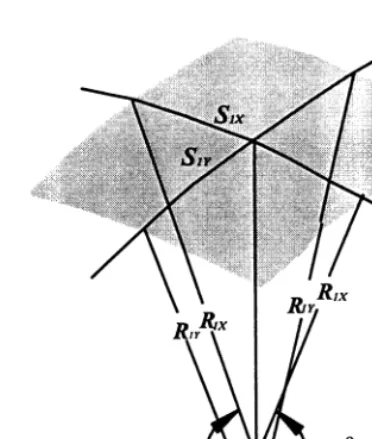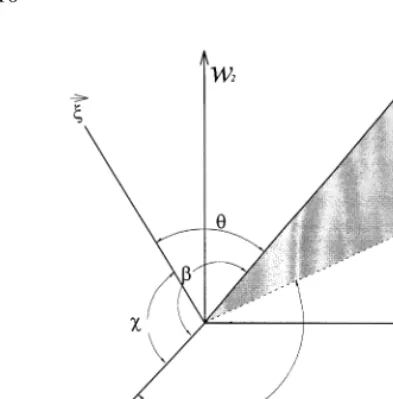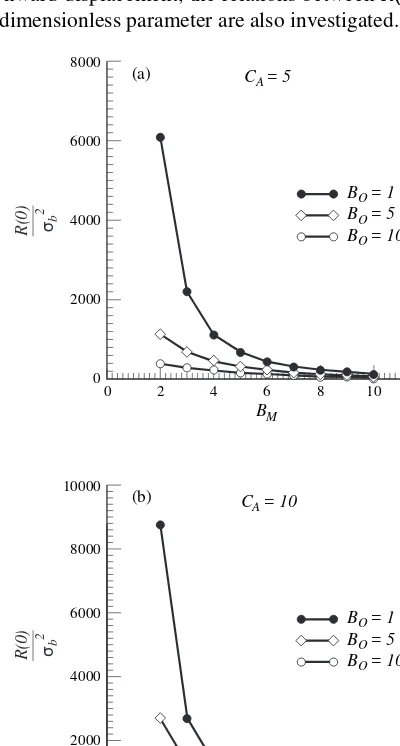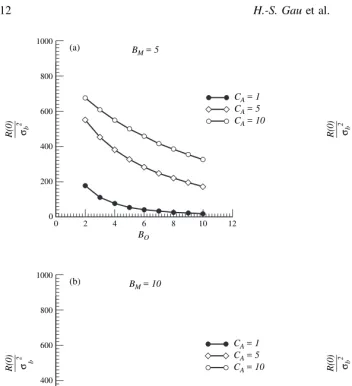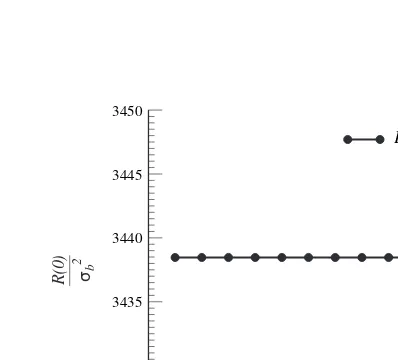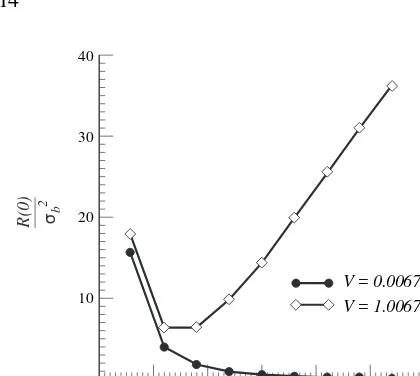Stochastic analysis of immiscible displacement in
porous media
Hwa-Sheng Gau
a, Chen-Wuing Liu
a ,* & Yii-Soong Tsao
ba
Department of Agricultural Engineering, National Taiwan University, Taipei, Taiwan, Republic of China
b
Department of Civil Engineering, National I-Lan Institute of Agriculture and Technology, I-Lan, Taiwan, Republic of China
(Accepted 26 March 1997)
The interface of two immiscible fluids flowing in porous media may behave in an unstable fashion. This instability is governed by the pore distribution, differential viscosity and interface tension between the two immiscible fluids. This study investigates the factors that control the interface instability at the wetting front. The development of the flow equation is based on the mass balance principle, with boundary conditions such as the velocity continuity and capillary pressure balance at the interface. By assuming that the two-phase fluids in porous media are saturated, a covariance function of the wetting front position is derived by stochastic theory. According to those results, the unstable interface between two immiscible fluids is governed by the fluid velocity and properties such as viscosity and density. The fluid properties that affect the interface instability are expressed as dimensionless parameters, mobility ratio, capillary number and Bond number. If the fluid flow is driven by gravitational force, whether the interface undergoes upward displacement or downward displacement, the variance of the unstable interface decreases with an increasing mobility ratio, increases with increasing capillary number, and decreases with increasing Bond number. For a circumstance in which fluid flow is horizontal, our results demonstrate that the capillary number does not influence the generation of the unstable interface.q1998 Elsevier Science Limited. All rights reserved
Key words:instability, wetting front, immiscible fluid, stochastic theory.
1 INTRODUCTION
The interface of two immiscible fluids flowing in porous media may behave in an unstable fashion. The instability is caused by pore distribution, differential viscosity, and interface tension between the two immiscible fluids18. The unstable phenomenon is called fingering, when the shape of the unstable wetting front resembles fingers. The velocity at the fingertips may be higher than the mean velocity, which may cause the aquifer contaminant to move much faster, subsequently increasing the risk of contaminating ground-water aquifers. Therefore, the factors controlling an unstable wetting front must be investigate to prevent and remediate groundwater contamination.
The physical mechanisms controlling the unstable inter-face between immiscible fluids have long been known to petroleum engineers. Recently, this problem has been reconsidered in the fields of soil physics and subsurface hydrology. Hill14derived a critical velocity, beyond which a finger develops from a perturbation. Chuoke et al.5
extended the work of Hill14by performing first-order stabi-lity analysis on an initial planar interface between two immiscible fluids moving through homogeneous porous media. They not only decomposed the perturbed macro-scopic interface into fundamental Fourier perturbation modes, but also studied each of these modes separately. The same critical velocity required for fingering onset as that of Hill14 was derived, but with the added constraint that the perturbation contains wavelengths exceeding a cri-tical wavelength. Chuokeet al.5indicated that both larger viscosity differences and higher velocities lead to smaller finger spacing, and larger interface tensions lead to wider finger spacing. These relationships derived by Chuokeet al.5 have been verified by laboratory studies5. Raats29presented a stability criterion for water infiltrating through the unsa-turated zone based on the hydraulic model of Green and Ampt13. He showed that a wetting front displacing air at constant atmospheric pressure is inherently stable due to imbibition at the advancing front. Hill and Parlange15 stu-died the unstable condition of two immiscible fluids flowing through two-layer, porous media, with fine soil on the upper
Printed in Great Britain. All rights reserved 0309-1708/98/$19.00 + 0.00
PII: S 0 3 0 9 - 1 7 0 8 ( 9 7 ) 0 0 0 1 7 - 1
605
layer and coarser soil on the lower layer. The unstable wetting front occurred when the flow rate through the coar-ser layer was less than the saturated hydraulic conductivity. Philip27,28extended the work of Raats29to incorporate the effects of surface tension. He concluded that a wetting front would be unstable if there exists a pressure gradient oppos-ing the direction of flow, and stable if the pressure gradient assists the flow. Based on the assumption that the speed of a perturbed front is affected by its curvature, Parlange and Hill26found that a wetting front moving in a homogeneous soil at a sufficiently low speed is unstable. The wavelength for fine-textured soils is larger than that for coarse-textured soils and increases with an increasing initial moisture con-tent. Mclean and Saffman25extended the work of Saffman and Taylor30to include the effect of surface tension due to interface curvature on a wetting front. Chang4introduced the fractal theory for analysing the wetting front instability in unsaturated soil. According to their results, the fractal dimen-sion can be used as a criterion to predict whether fingering would occur in porous media and the minimum spatial dis-tance required to detect the dominant fingering location. Glass12 derived expressions by dimensional analysis for finger width and finger velocity that are functions of porous media properties and initial or boundary conditions. Glasset al.11extended the analyses of Parlange and Hill26to investi-gate finger diameter, including the relationships between the velocity of curves and radii of curvature with axisymmetric disturbances in a three-dimensional system.
Natural porous media, however, contain a distribution of pore sizes that cause the intrinsic permeability to vary in space. Consequently, different parts of an initially planar interface move with different velocities through the porous media, and the wetting front becomes unstable2. Within each soil type or geologic unit, the properties of these elements are assumed to originate from frequency distribution. If the dis-tribution is monomodal, the medium is homogeneous; if it is multimodal, it is heterogeneous9. From this classification, the outcome of intrinsic permeability is a stochastic process. Consequently, determining the velocity of different parts of the interface between immiscible fluids becomes a stochastic process. Many researchers have investigated the variance of permeability in saturated porous media1,6,10,31and unsatu-rated porous media17,22–24,32,33,35 by stochastic theory. In this paper, we adopt stochastic theory to derive the auto-covariance function of the wetting front position. Parameters that control the interface instability of the wetting front are investigated from the auto-covariance function of wetting front position. In addition, quantitative results are discussed in detail to further understand instability in wetting fronts between immiscible fluids.
2 INTERFACE CONDITIONS
2.1 Capillary pressure and unstable wetting front
The pore diameter affects the flow path in a porous media. The curvature of the wetting front through larger pores is
less than that through finer pores. Therefore, the fluid inter-face moves easily through media with large pores because the energy stored in the interface quickly exceeds the inter-face tension. The pore diameter in the actual porous media, however, is a function of position. Thus, the displacement varies in different parts of the interface.
If the interface between the two immiscible fluids is assumed to be an impermeable membrane, the displacement of the interface, which is attributed to the forces around the membrane, will be unbalanced. The differential force of the interface can be represented as follows:
DP¼P1¹P2 (1)
whereP1andP2denote the pressures of the two immiscible fluids, andDPrepresents the capillary pressure between the two immiscible fluids. If the differential displacement dhis caused by theDP, then the work of the interface surface can be expressed as the product of the pressure difference and differential displacement. In addition, the work can be expressed as surface tension work on the surface. There-fore, based on the equality of work4, this can be represented as
(P1¹P2)dh Z
dA1¼j Z
d(DA) (2)
where dA1is a finite surface area,j(MT ¹2
) is the interface tension, and d(DA1) is the net increase in finite surface area as the curvature of the surface is increased. The integral variables are different in eqn (2). Therefore, the relation-ship between dA1and d(DA1) needs to be established.
Chang4has derived the work for a two-dimension case; it also can be expanded to a three-dimensional case. LetR1X
andR1Ybe the principal radii,S1XandS1Ybe the length of
the principal section curvature, andv1Xandv1Ybe the angles
of the finite principle radii, as shown in Fig. 1. After a small displacement, dh, the principal radii, the length of the prin-cipal section curvature and the angles of the prinprin-cipal radii are changed and denoted as R2X,R2Y,S2X,S2Y,v2X,v2Y. By
assuming that the displacement is extremely small, the changes in the angles of the principal radii can be neglected, i.e.v2X¼v1Xandv2Y¼v1Y, and the lengths of the principal
sections of curvature,S2XandS1X,S2Y, andS1Yare related by
the law of sines. Then, the surface areas, dA1and dA2, can be approximated by the product of the lengths of the principal sections of curvature, S1X and S1Y,S2X, and S2Y,
respectively. By subtracting dA1from dA2, the net increase in area caused by a small displacement can be derived. By neglecting the second-order term, the net increase in surface area is expressed as
dDA¼dA1dh
1 R1Xþ
1 R1Y
(3)
dDA< ¹ ]2Zh
]X2 þ ]2Zh
]Y2
dA1dh (4)
whereZhdenotes the position of the surface in the
z-direc-tion. The negative sign in eqn (4) indicates the surface curvature is convex. From eqn (2), eqn (3) and eqn (4), the relationship between the capillary pressure and surface curvature is expressed as
P1¹P2
ÿ
¼ ¹j ] 2Z
h ]X2 þ
]2Zh
]Y2
(5)
2.2 The interface velocity
Although a pressure difference exists across the interface, the velocity of particles located on the interface should be equal. The analysis of Glass11uses a relationship between interface velocity and curvature established by Parlangeet al.26, with the addition of a perturbation velocity that exists in the inter-face, to approach the velocity of the interface as follows
U¼V¹G 1
R1X
þ 1
R1Y
þ]h
]t (6)
whereU(LT¹1) denotes the velocity of the interface, andV(LT¹1) represents the mean velocity of the fluid. The perturbation velocity, determined by the first derivative of the perturbation displacementhwith respect to time,G(L2T), is defined for the fluid that would spontaneously displace the other by capillary action. In the remainder of this paper, we take this to be the displacing fluid. It is expressed as11
G¼
Z
PF
rFg
PO rOg
Kd P
rg
vF¹vO
(6-1)
where K(L/T) denotes the hydraulic conductivity, v
represents the fluid content, r(ML¹3) is the density of fluid, g(LT¹2) denotes the gravitational acceleration con-stant, and the subscripts OandF represent values in front of and in back of the diffusive zone, respectively. G is important due to the existence of a capillary fringe. Fetter8 pointed out that the capillary fringe is very thin, since both the immiscible fluids are liquid, thusGis neglected in this study, since the density and pressure differences across the diffusive zone are not too large. Therefore, the velocity of the interface is simplified to
U¼Vþ]h
]t (7)
Darcy’s law is generally adopted to describe the flow through non-deformable, porous media within the regime of small Reynolds numbers, where inertial forces are neg-ligible relative to viscous forces. It can be expressed as follows
Ui¼ ¹k
mivi ]Pi
]Zþrig
i¼1,2 (8) wherek(L2) denotes the intrinsic permeability,m(ML¹1T¹2) represents the viscosity, and the subscripts 1 and 2 are the type of fluid. By assuming that pore volume conducting either fluid is the same, v1¼v2¼vfis adopted.
If the direction of gravity is assumed to be parallel to the base flow velocity, in view of eqn (7) and eqn (8), the relationships among the pressure, velocity and position at the interface can be expressed as follows
¹k
mivf ]Pi
]Zþrig
¼Vþ]h
]t i¼1,2 (9)
3 STOCHASTIC MODEL
3.1 Immiscible flow equations
For two incompressible immiscible fluids (denoted by 1 and 2) having different viscosities and densities within the por-ous media, the equation of continuity gives
=· k
m1vf
= P1þr1gZ
ÿ
¼0 (10)
=· k
m2vf
= P2þr2gZ
ÿ
¼0
eqn (10) is a Laplace-type equation. To find a solution for the flow velocity, the specific boundary conditions must be given. Twelve boundary conditions are required to solve eqn (10). Two boundary conditions have been imposed at the interface between the two fluids. The other conditions are set as theP1þr1gZandP2þr2gZ, bounded asX,Y→¹`and`, respectively, to simplify the problem.
One of the interface conditions is expressed as eqn (5). The other interface condition reflects the continuity of velocity
at the interface
If the natural logarithm of intrinsic permeability, lnk, the pressure,P, and the position of the interface,H, are assumed to be second-order stationary stochastic processes, eqn (10) and eqn (11) become stochastic partial differential equations. lnk,PandHcan be decomposed into mean values and fluc-tuations of these values around their means, i.e.
lnk¼Bþb,B¼E[lnk],E[b]¼0 (12) Pi¼P¯iþPi9, P¯i¼E[Pi], E[P9]¼0
H¼H¯ þh, H¯ ¼E[H], E[h]¼0
whereB,P¯iandH¯ denote the means of lnk,PiandH, and
b,Pi9 andh represent the perturbations of lnk,PiandH,
respectively. Substituting eqn (12) into the governing eqn (10), yields
By subtracting the mean equation from eqn (13), a pertur-bation equation is obtained as
]2P19
For the boundaries in the interface, the perturbation equa-tions can be derived by substituting eqn (12) into eqn (11) and eqn (5), then subtracting the mean equation from the perturbation equation. Therefore,
After perturbation analysis, three dependent variables,
P19,P29 and h exist in eqn (14), as the mean pressure gradient is assumed to be constant. Therefore, eqn (9) is included in the boundary conditions. The perturbation equa-tion of eqn (9) is thus derived as follows
eB
The assumption of statistical stationarity is frequently employed in stochastic hydrogeology. The stationarity assumption enables a variety of analytical techniques, e.g. Fourier transformation theory, to be used to solve stochastic flow and transport problems. Herein, the intrinsic perme-ability and the position of the interface in space are assumed to be stationarities. Thus, derived perturbation variables can be represented by the Fourier–Stieltjes Integral34:
b¼
wherewidenotes a componentiof the wave number vectorw,
and dZhand dZbrepresent the complex Fourier amplitudes of
the fluctuationsbandhover wave number spacew. Although the intrinsic permeability is stationarity, the perturbation term of pressure always varies according to the imposed boundary con-ditions20. Li and Mclaughlin20 represented the nonstationarity perturbation term as a stochastic integral, expanded in terms of transfer functionsfi(X,w) over the stationarity increment dZb(w) By assuming that the perturbation term of pressure is nonsta-tionary only in the Z-direction and does not vary in other directions, the transfer functions can be simplified as follows
fi(X,w)¼f¯i(Z,w3)ei(w1Xþw2Y) (21)
Substituting eqn (18), eqn (19), eqn (20) and eqn (21) into eqn (14), eqn (15), eqn (16) and eqn (17), and neglecting the quadratic terms of perturbation yield
whereC2andC3are undetermined coefficients, and
Caryet al.3provided the positions of the front between two immiscible fluids versus time. They observed fluids infil-trating into both the tops and bottoms of columns in a laboratory experiment and recorded the time required for all the fluid fronts to move. A linear relationship between the fluid fronts and time is established after several hours. Therefore, the mean position of the interface H¯ is simpli-fied as
¯
H¼Vt (25)
By substituting eqn (25) into eqn (22) and eqn (24),C2and C3can be determined as
where
eqn (23) is the spectrum relationship between the position of the interface and the intrinsic permeability in the fre-quency domain. Based on time-series analysis21,34, the auto-covariance function for the position of the interface can be represented as
R(y)¼
Z
ev¯w·~~yE dZhdZhp
(28)
where y denotes the length of the separation vector, and dZp
h represents the complex conjugate of dZh. The
expectation of E dZhdZhp
can be derived by substituting eqn (26) and eqn (27) into eqn (22) and eqn (23). The above results include the spectrum of the logarithm of intrinsic permeability. The spectrum of the logarithm of intrinsic permeability derived by Yeh35 for three-dimensional environments is adopted, and expressed as follows
sbb¼
j2bl3
p21þl2ÿw21þw22þw2312 (29)
wherejbdenotes the variance of the logarithm of intrinsic
permeability, and lrepresents the correlation length. Sub-stituting eqn (29) into eqn (28) and expressing the auto-covariance function in spherical coordinates, eqn (28) can
be rewritten as
wetting front increases. Thus, the variance of the interface position can be viewed as a criterion to define an unstable wetting front. Eqn (30) is not easy to integrate analytically. Herein, the oscillatory technique developed by Davies et al.7is adopted to solve this problem.
4 RESULTS AND DISCUSSION
The exponential function,eGt¯ , in eqn (30) (see Appendix A) is a function of time. Thus,G¯ can be viewed as a criterion to predict whether or not an unstable interface occurs in porous media. The unstable interface occurs asG¯ becomes greater than zero, because the auto-covariance calculated from eqn (30) increases over time t. For the stable interface, auto-covariance decreases over time as G¯ becomes less than zero. The terms that determine whether G¯ is positive or negative can be rearranged as follows
Vvf(m2¹m1)¹r2eBjþ(r2¹r1)geB (31)
where the first term and third term are constant values, and the second term is varied with rand always greater than zero. The fluid properties must satisfy the following equa-tion to allowG¯ to have a negative value
Vvf(m2¹m1)þ(r2¹r1)geB,0 (32)
eqn (32) is the criterion of a stable interface. The stability
depends on the fluid flow velocity and fluid properties, and the critical velocity, Vc, can be obtained by setting the
equation equal to zero. The relationship between m2, m1 and r2 , r1 define the conditions of absolute stability as the fluid flow direction opposes the gravitational direction (upward displacement, i.e. fluid 1 displaces fluid 2), while
m2.m1andr2,r1are the conditions for stable flow as the fluid direction and gravitational direction are the same (i.e. fluid 2 displaces fluid 1, and the velocity has a negative value). Table 1 lists the other conditions of stability for the combination of different fluid properties. Those results cor-respond to those of Kueper18.
Three dimensionless parameters,BM,CAandBO, appear
in eqn (30).BMis known as the mobility ratio, defined as the
mobility of the displacing fluid, divided by the mobility of the displaced fluid. If the mobility ratio is greater than one, it favours the flow of the displacing fluid, whereas if this ratio is less than one, it favours the flow and recovery of displaced fluid. CA is the capillary number, defined as the ratio of
viscous and capillary forces. Larson et al.19 compiled numerous experimental data of oil mobilization by water flooding, indicating that residual saturation correlates strongly with the value of the capillary number. Hunt et al.16 also indicated that residual oil can be displaced if the capillary number exceeds 2 3 10¹5. B0 is the Bond number, i.e. the ratio of gravitational and surface tension forces.
To understand the relations between the interface growth and the dimensionless parameters, the non-dimensional ana-lysis of R(0)=j2
b is carried out. The cases of unconditional
instability in Table 1 are selected. The relations BM.1, B0.1 and BM,1, B0.1 are adopted for
upward and downward displacements, respectively. Other physical properties used in the analysis are shown in Table 2. In the upward displacement case, the profiles of R(0)=j2 b
versus BM for capillary numbers equal to 5 and 10 are
shown in Fig. 3a and b, respectively. According to these results, R(0)=j2b decreases as the mobility ratio decreases.
Notably, that increasing the Bond number results in a shal-low slope, while a shal-lower Bond number yields a steeper slope. Fig. 4a and b display the profiles of R(0)=j2b versus
CA for mobility ratios equal to 5 and 10, respectively. The
R(0)=j2b value initially increases with increasing CA while
the slope of the profile gradually decreases. TheCA is
pro-portional to V, m1 and j¹1. Thus, the perturbation in the
interface increases with increases of the mean flow velocity as the physical properties are fixed. Therefore, this result
Fig. 2.Coordinate system of wave number and separation vectors
relations.
Table 1. The fluid properties for stable displacement
Upward displacement Downward displacement
Fluid properties Stable condition Fluid properties Stable condition
r1.r2,m1,m2 V,VC r2.r1,m2,m1 Always unstable
r1.r2,m1.m2 Always stable r2.r1,m2,m1 V.VC
r1,r2,m1,m2 Always unstable r2,r1,m2,m1 V,VC
clearly suggests that the perturbation of the interface is not affected by the capillary number when the mean velocity is sufficiently larger than the critical velocity. The profiles of R(0)=j2b versusB0 for mobility ratios equal to 5 and 10 are shown in Fig. 5a and b, respectively. The above results demonstrate that R(0)=j2
b decreases with an increasing
B_{0}. The Bond number is proportional to the mean intrin-sic permeability andj¹1. Thus, the unstable interface front is more easily formed in the sandy formation than in the clayey formation. On the other hand, the perturbation of the interface increases with an increasing tension of interface.
If the fluid flow is driven by gravitational force, the inter-face of the two fluids moves in the gravitational direction. In downward displacement, the relations betweenR(0)=j2b and
the dimensionless parameter are also investigated. The flow
velocity,V, and capillary number,CA, are defined as
nega-tive values, since the fluid flow direction is opposite to the reference coordinate. The profiles ofR(0)=j2bversusBM,CA,
BOare shown in Fig. 6, Fig. 7, and Fig. 8, respectively. The
R(0)=j2
b increases with increasing BM and decreases with
increasingCAandBOrespectively. In this case, the mobility
ratio is equal to the inverse ofBM, since fluid 2 displaces
fluid 1. Thus the R(0)=j2
b decreases as the mobility ratio
increases. The negative sign on the capillary number results because the flow direction is opposite to the reference coor-dinate; the capillary number of a fluid with a large mean velocity is less than that of a fluid with a small mean velo-city. Therefore, theR(0)=j2bincreases with increases in mean
velocity as the fluid properties are fixed. This result is con-sistent with the previous discussion of the upward displace-ment case.
For a horizontal flow case, the Bond number is set to be zero and, hence, the gravitational force is neglected in eqn (30). Fig. 9 displays the profiles ofR(0)=j2
bversus capillary
numbers. The result shows that the generation of an unstable interface is not affected by capillary number. Therefore, eqn (30) is simplified by setting the capillary number equal to Table 2. Physical condition of porous media and fluids
Relation length 100 m
Mean value of intrinsic permeability 100-7m2
Mean value of velocity 6.7310-3m/day
Porosity 0.4
Time 1.0 day
8000
12 (a)
0 6000
4000
6 4
0 2
BM
8 10
2000 R(0) σb
2
BO = 1
CA = 5
BO = 5
BO = 10
10000
12 (b)
0 6000
4000
6 4
0 2
BM
8 10
2000 R(0) σb
2
BO = 1
CA = 10
BO = 5
BO = 10
8000
Fig. 3.The variance of unstable interface versus mobility ratio in
the upward fluid flow system. The relation with different capillary numbersCA¼1 andCA¼10 are shown in (a), (b) respectively.
1000
12 (b)
0 600
400
6 4
0 2
CA
8 10
200 R(0) σb
2
BO = 1
BM = 10
BO = 5
BO = 10
800 1000
12 (a)
0 600
400
6 4
0 2
CA
8 10
200 R(0) σb
2
BO = 1
BM = 5
BO = 5
BO = 10
800
Fig. 4.The variance of unstable interface versus capillary number
infinity. The results are shown in Fig. 10. The change of R(0)=j2b decreases with an increasing mobility ratio, when
the mean velocity is small. Nevertheless, a critical mobility ratio is apparent in Fig. 10, when the mean velocity is large. Ther1. r2,m1. m2value decreases with an increasing mobility ratio, if the mobility ratio is less than the critical mobility ratio. When the mobility ratio becomes larger than the critical mobility ratio,R(0)=j2
b increases as the mobility
ratio increases. In other words, the generation of an unstable interface not only depends on the mobility ratio, but is also affected by the mean flow velocity.
5 CONCLUSIONS
This study presents a two-phase stochastic flow model of the variance of interface displacement. Parameters that control the interface instability of the wetting front are investigated from the auto-covariance function of the interface displace-ment. Computational results indicate that the covariance of interface displacement is a function of mobility ratio, capil-lary number and Bond number. The directions of flow and
velocity of the fluids are also important factors that control the instability of the wetting front. Based on results obtained from front instability, we can conclude the following:
1. An unstable interface between two immiscible fluids is governed by the fluid properties, such as viscosity and density. The conditions of stability differ with the direction of fluid movement and the combination of viscosity and density. The relations of
r1.r2, m1.m2 and r1,r2, m1,m2 (fluid 1
dis-places fluid 2) are the fluid properties defining the absolute stable and unstable conditions, respectively, for the upward displacement case. The relations of
r1,r2, m1.m2 and r1.r2, m1,m2 (fluid 2
dis-places fluid 1) are the fluid properties defining the absolute stable and unstable conditions, respectively, for the downward displacement case. The other con-ditions of stability for different combinations of fluid properties depend on whether the velocity exceeds a critical velocity. The critical velocity is a function of fluid properties and mean intrinsic permeability.
1000
12 (b)
0 600
400
6 4
0 2
BO
8 10
200 R(0) σ b
2
CA = 1
BM = 10
CA = 5
CA = 10
800 1000
12 (a)
0 600
400
6 4
0 2
BO
8 10
200 R(0) σb
2
CA = 1
BM = 5
CA = 5
CA = 10
800
Fig. 5.The variance of unstable interface versus bond number in
the upward fluid flow system. The relation with different mobility ratiosBM¼5 andBM¼10 are shown in (a), (b) respectively.
120000 (b)
0 R(0) σb
2
CA = –10
40000
1.00 (a)
0
0.60 0.40 0.00 0.20
BM
0.80 R(0) σb
2
BO = 1
CA = –5
BO = 5
BO = 10
30000
20000
10000
100000
80000
60000
40000
20000
1.00 0.60
0.40
0.00 0.20 0.80
BO = 1
BO = 5
BO = 10
BM
Fig. 6.The variance of unstable interface versus mobility ratio in
the downward fluid flow system. The relation with different capil-lary numbers CA ¼ ¹5 and CA ¼ ¹10 are shown in (a), (b)
2. The mobility ratio, capillary number and Bond number are three important, dimensionless para-meters that affect the interface instability. These results demonstrate that regardless of whether the interface is displaced upward or downward, the var-iance of an unstable interface decreases with an increasing mobility ratio, increases with an increasing capillary number, and decreases with an increasing Bond number.
3. The capillary number is insignificant in the creation of an unstable interface for the case of horizontal fluid flow. The relation ofm2.m1(fluid 1 displaces fluid 2) is always unstable for horizontal displacement. The tendency of the profile of R(0)=j2
b versus mobility
ratio depends on mean velocity. Also, R(0)=j2 b
decreases with increasing mobility ratio as fluids flow through porous media with a small mean velo-city. A critical mobility ratio exists as fluids flow through porous media with a large velocity. The R(0)=j2b value decreases with an increasing mobility
ratio when the mobility ratio is less than the critical
BM = 0.5
120000 (b)
0 R(0) σb
2
BM = 0.9
25000 (a)
0 R(0) σb
2
20000
15000
10000
100000
80000
60000
40000
20000
0 –6
–8
–12 –10 –4
BO = 1
BO = 5
BO = 10
CA
–2 0 –6
–8
–10 –4
BO = 1
BO = 5
BO = 10
CA
–2 –12
5000
Fig. 7.The variance of unstable interface versus capillary number
in the downward fluid flow system. The relation with different mobility ratios BM ¼ 0.5 and BM ¼ 0.9 are shown in (a), (b)
respectively.
BM = 0.5
120000 (b)
0 R(0) σb
2
BM = 0.9
25000 (a)
0 R(0) σb
2
20000
15000
10000
100000
80000
60000
40000
20000
12 6
4
0 2 8
CA = 1
CA= 5
CA = 10
BO
10
CA = 1
CA = 5
CA = 10
5000
12 6
4
0 2 8
BO
10
Fig. 8. The variance of unstable interface bond number in the
downward fluid flow system. The relation with different mobility ratiosBM¼0.5 andBM¼0.9 are shown in (a), (b) respectively.
3450
R(0) σb
2
BM = 3
12 6
4
0 2 8
CA
10 3445
3440
3435
3430
3425
Fig. 9.The variance of unstable interface versus capillary number
mobility ratio. In addition, it increases with increasing mobility ratio when the mobility ratio exceeds the critical mobility ratio.
ACKNOWLEDGEMENTS
The authors would like to thank the National Science Council of the Republic of China for financially supporting this work under Contract No. NSC-83-0409-b-197-002.
APPENDIX A Stochastic analysis of spatial variability in subsurface flows 1. Comparison of one- and three dimension flows. Water Resour. Res., 1978,14,263–270.
2. Bentsen, R. G. A new approach to instability theory in porous media.Society of Petroleum Engineers, 1985,25,765–779. 3. Cary, J. W., Mcbride, J. F. & Simmons, C. S. Observation of water and oil infiltration into soil: some simulation chal-lenges.Water Resour. Res., 1989,25,73–80.
4. Chang, W.-L. T., Fractal analysis of wetting front instability in unsaturated soil. Ph.D. thesis, Dep. of Soil Sci., University of California, Davis, 1989.
5. Chuoke, R. L., Van Meurs, P. & Van Der Pol, C. The instability of slow, immiscible, viscous liquid displacement in Permeable media petrol. Trans. AIME, 1959,216,188– 194.
6. Dagan, G. Solute transport in heterogeneous porous forma-tion.J. Fluid Mech., 1984,145,151–177.
7. Davis, P. J. and Rabinowitz, P.,Methods of Numerical Inte-gration, 2nd edn, Academic, San Diego, CA, 1984. 8. Fetter, C. W., Contaminant Hydrogeology. Macmillan Inc.,
New York, 1993.
9. Freeze, R. A. A stochastic-conceptual analysis of 40
Fig. 10.Variance of unstable interface versus the mobility ratio in
one-dimension groundwater flow in nonuniform homoge-neous media.Water Resour. Res., 1975,11,725–740. 10. Gelahr, L. W. & Axness, C. L. Three-dimensional stochastic
analysis of macro dispersion in aquifer.Water Resour. Res., 1983,19,161–180.
11. Glass, R. J. Immiscible displacement in porous media: stabi-lity analysis of three-dimension, axisymmetric disturbances with application to gravity-driven wetting front instability.
Water Resour. Res., 1991,27,1947–1956.
12. Glass, R. J., Parlange, J.-Y. & Steenhuis, T. S. Wetting front instability 1. Theoretical discussion and dimension analysis.
Water Resour. Res., 1989,25,1187–1194.
13. Green, W. H. & Ampt, G. A. Studies in soil physics 1. The flow of water and air through soils.J. Agric. Soc., 1911,4,1– 24.
14. Hill, S. Channelling in packed columns. Chem. Eng. Sci., 1952,1,247–253.
15. Hill, D. E. & Parlange, J.-Y. Wetting front instability in layered soils.Soil Sci. Am. Proc., 1972,36,697–702. 16. Hunt, J. R., Sitar, N. & Udell, K. S. Nonaqueous phase liquid
and cleanup 1. Analysis of mechanisms.Water Resour. Res., 1988,24,1247–1258.
17. Kiefer, E. M. A conceptual-stochastic model of unsaturated flow in heterogeneous soils.J. of Hydrology, 1993,143,3–9. 18. Kueper, B. H. & Frind, E. O. An overview of immiscible fingering in porous media.J. Contam. Hydrol., 1988,2,95– 110.
19. Larson, R. G., Scriven, L. E. & Davis, H. T. Percolation theory of two phase flow in porous media.Chemical Engi-neering Science, 1981,36,57–73.
20. Li, S. G. & McLaughlin, D. A nonstationary spectral method for solving stochastic groundwater problem: unconditional analysis.Water Resour. Res., 1991,27,1589–1605. 21. Lumley, J. L. and Panofsky, H. A.,The structure of
atmo-spheric turbulence. Wiley Interscience, New York, 1964. 22. Mantoglou, A. & Gelhar, L. W. Stochastic modeling of
large-scale transient unsaturated flow systems.Water Resour. Res., 1987,23,37–46.
23. Mantoglou, A. & Gelhar, L. W. Capillary tension head
variance, mean soil moisture content, and effective specific soil moisture capacity of transient unsaturated flow in strati-fied solis.Water Resour. Res., 1987,23,47–56.
24. Mantoglou, A. & Gelhar, L. W. Effective hydraulic conduc-tivities of transient unsaturated flow in stratified soils.Water Resour. Res., 1987,23,57–67.
25. Mclean, J. W. & Saffman, P. G. The effect of surface tension on the shape of fingers in a Hele-Shaw cell.J. Fluid Mech., 1981,102,455–469.
26. Parlange, J.-Y. & Hill, D. E. Theoretical analysis of wetting front instability in soils.Soil Sci., 1976,122,236–239. 27. Philip, J. R. Stability analysis of infiltration. Soil. Sci. Soc.
Am. Proc., 1975,39,1042–1049.
28. Philip, J. R. The growth of disturbance in unstable infiltration flows.Soil. Sci. Soc. Am. Proc., 1975,39,1049–1053. 29. Raats, P. A. C. Unstable wetting fronts in uniform and
non-uniform soils.Soil. Sci. Am. Proc., 1973,37,681–685. 30. Saffman, P. G. & Taylor, G. I. The penetration of a fluid into
a porous medium or Hele-Shaw cell containing a more vis-cous liquid.Proc. R. Soc. London. Ser. A., 1958,246,312– 331.
31. Smith, L. & Freeze, R. A. Stochastic analysis of steady state groundwater flow in a bounded domain 2. Two-dimension simulation.Water Resour. Res., 1979,15,1543–1559. 32. Unlu, K., Kavvas, M. L. & Nielsen, D. R. Stochastic analysis
of field measured unsaturated hydraulic Conductivity.Water Resour. Res., 1989,25,2511–2521.
33. Unlu, K., Nielsen, D. R. & Biggar, J. W. Stochastic analysis of unsaturated flow: one-dimensional monte carlo simula-tions and comparisons with spectral perturbation analysis and field observations. Water Resour. Res., 1990, 26, 2207–2217.
34. Wei, W.-S. W.,Time series analysis. Addison-Wesley, Red-wood City, 1990.
